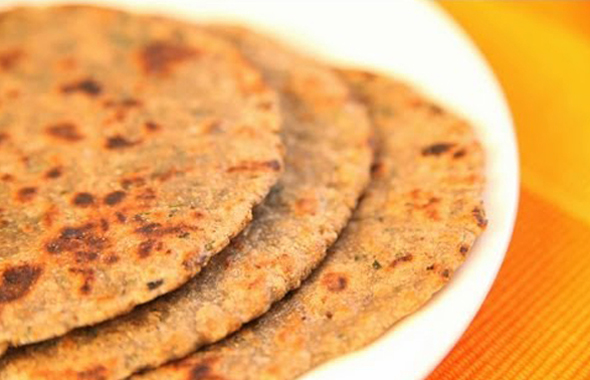Mama’s Punjabi Recipes: Bajre Gur Di Roti (Pearl Millet & Jaggery Flatbread)
Saved under Community, Current Stories, Recipe Corner
Tags: Bajre Gur Di Roti, Baytown, Clear Lake, Cypress, Desi news, Greater Houston, Houston, Houston Desi news, India, Indian American community, Indian News, Indians in America, Indo-American News, Katy, Mama’s Punjabi Recipes, NRI, pearland, Shakuntla Malhotra, south asia, South India, Sugar Land, Texas, USA
By popular demand, here is a reprint of Mama’s Bajre Gur Di Roti recipe, which is just the kind of tasty, hot sweetbread that you need for the winter months to take your mind off the bitter cold outside. It is reprinted with some additional information and directions.
This recipe is made with the bajra (pearl millet) grain about which we young girls growing up in Lyallpur and Jhung used to sing a song in Jhungi Punjabi:
Bajre de olle veh, menu banna veh pewa deh,
(Oye, build me a wall, hey, besides the millet wheat bush)
Main chiddiyan ouwandi thuk gayi hun
(I’m tired of shooing away the birds that peck at it)
Bajra is part of the Punjabi folklore, celebrated in songs associated with birds and their flights in the air. There is a well-known Punjabi folksong, Bajra da Sitta (the cobb of bajra) which was made famous in the 1940s by Prakash Kaur and Surinder Kaur that went “Bajre da sitte veh assan talli te maroreya” (we scrapped the cobb of bajra between our palms).
Bajra gur di rotti (pearl millet and jaggery flatbread) is about as rustic a Punjabi roti as you can get, just like makki di roti (corn flatbread). And it is also a comfort food to ward off the cold of the winter months and give warmth and energy to do all the household chores. Since we grew up in Lyallpur, which, though it was the District Center, was still a small town, we would get fresh grains by the jute bag full from our farmlands and also the deep brown bricks of gur (jaggery, an uncentrifuged concentrated sugar made from cane juice).
Bajra is a type of grass with a small seed grain, which has a short season growing under, dry, high temperature conditions. Bajra is high in protein and a good source of iron, vitamins B1, B2 and B3 and is gluten free. It has no saturated fat or cholesterol and the flour contains about 260 calories per half cup.
In the winter months, bajra roti provides warmth. You simply make the bajra atta (dough) and then you can make the pancakes between the palms (as the dough can be too tender to spread with a rolling pin) and let them cook over low heat on a tava (iron flat skillet). This is a really tasty sweet roti that goes down well with hot milk and makes you feel warm all over during the cold of winter.
Ingredients:
• 2 cups bajre da atta (pearl millet flour)
• ½ cup gur (jaggery)
• ½ cup ghee (clarified butter)
• 1 tsp saunf (fennel seed)
• 1 cup pani (water). You can also use 1 cup of milk instead of water.
• Vegetable or sunflower oil to grease the hands and tava
Directions:
1. Heat the water and add the gur. Stir till the gur is melted. Let it cool down for 30 minutes.
2. Pour the bajra atta in bowl and add the ghee. Mix thoroughly. Add the cool gur water mixture a little at a time and knead the flour till it is soft.
3. Grease your hands with a little oil and break away some dough and make a ball between the palms till it is about 4 to 6 inches in diameter.
4. Heat the tava on medium and then coat with a little bit of oil.
5. Place the pancake on the tava. When it turns a little brown, flip it over. Wait for both sides to be browned but do not overcook else the roti will burn.
6. Make the rotis out of the rest of the flour. Serve while hot with hot milk.
MAMA’S TIP OF THE WEEK: CAREFUL STEPS TO BOILING MILK SO IT DOESN’T SPILL OR BURN
If the milk in the fridge is getting close to the expiration date or has already gone over a day or two, place it in a pot and let it boil. This will kill any microbes and the milk will be good for another week to ten days.
When boiling milk, place a spoon of water in the saucepan to coat the insides. This way, the milk will not stick to the sides and burn when it boils. Always place the milk under low heat to let it boil gently, and when it does boil, pierce the top soft film that rises up with a knife in order to avoid the milk from bubbling over and spilling.

Shakuntla Malhotra is a skilled cook of Punjabi dishes made in the old-fashioned style that she learnt as a young woman in her ancestral home in Lyallpur, India (since renamed Faisalabad) before it became part of Pakistan after the Partition in 1947. People have often admired her cooking for its simplicity and taste that comes with each mouthful. Even in her late-eighties, she continues to cook daily and agreed to share her delectable Punjabi vegetarian recipes for future generations.

